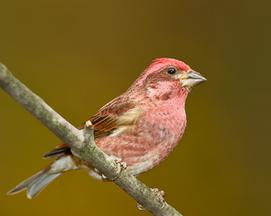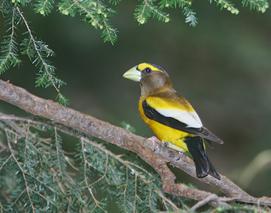LAZULI BUNTING, PURPLE FINCH, ORANGE-CROWNED WARBLER, WILSON'S WARBLER, WARBLING VIREO, EVENING GROSBEAK OR-365
Willamette Valley, William L. Finley National Wildlife Refuge, Oregon
May 23, 6:25 a.m.
Sunrise at 5:37 a.m.
Here is the kind of payoff that one gets for patience, for simply standing and listening to all that sings.
Lazuli bunting: This style of singing from this bunting has so fooled me on occasion when I couldn't see the bird. The first song begins with four phrases of one kind, then just two of another. The second song (at 0:12) is more typical, with song phrases mostly in pairs, but then he reverts back to the shortened songs that begin with four or five notes of the same type.
Purple finch: A little after 5:00, the lazuli bunting is joined by a purple finch (e.g., 5:05), who sings his rich, rising warble until about 6:50.
Orange-crowned warbler. The warbler joins, too, first heard well at 5:13, and he continues through to the end, at 11:30.
The lazuli bunting, purple finch, and orange-crowned warbler are loud and clear, but other wonderful sounds occur in the background:
Wilson's warbler. At 1:51, my ears pick up, as I hear the unmistakable uncertainty in a young bird's song. The song is choppy, successive notes uneven, the sure sign of a young bird. I hear him better in the following minutes (e.g., at 2:14 and 2:20), last hearing him a little after 5:00.
Warbling vireo. At 8:33, I hear the musings of what sounds like yet another young male. He begins with soft, amorphous, babbling notes, and I have no clue until he gets his act together and concludes with the unmistakable undulating quality of a warbling vireo song. He's last heard about 10:00.
Evening grosbeak. Sightings and hearings of evening grosbeaks always seem to be fleeting, as they always seem to be in a hurry to go somewhere. I first hear one of their buzzy calls at 4:23, and the downslurred tonal note soon follows (at 4:23), but within 20 seconds they've faded into the distance.
Background
Canada goose, Bewick's wren, yellow-breasted chat, red-winged blackbird, cedar waxwing, train with universal long-long-short-long whistle, ring-necked pheasant (e.g., 5:12), Swainson's thrush, brown-headed cowbird, killdeer, pied-billed grebe, and what is that screech at 9:54?

Photo by Wil Hershberger

Photo by John Van de Graaff
